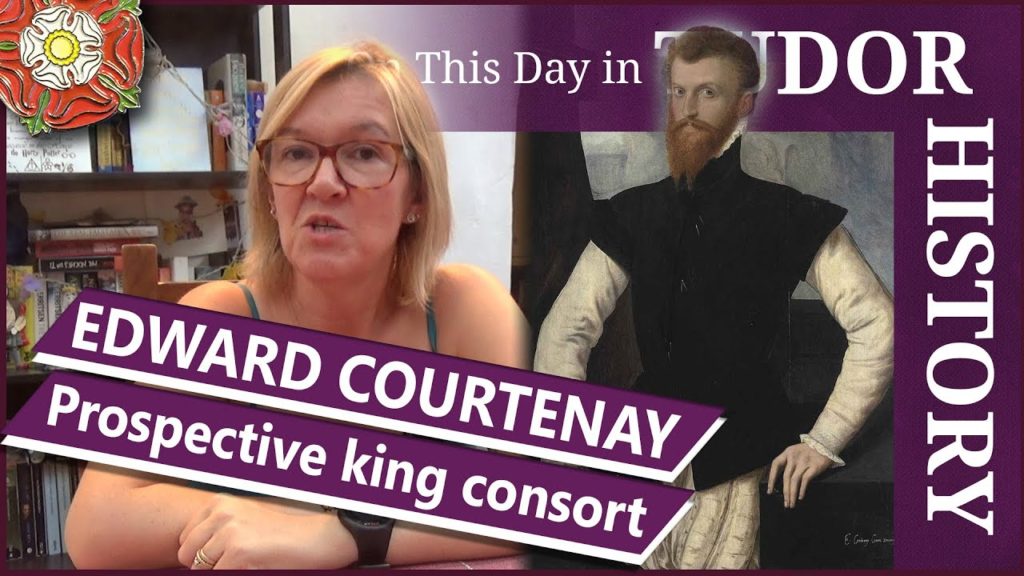On this day in Tudor history, 18th September 1556, Edward Courtenay, 1st Earl of Devon, died from a fever at Padua in Italy.
Courtenay had been sent overseas after he was implicated in Wyatt's Rebellion as a future husband and consort of Queen Mary I's half-sister, Elizabeth, the future Queen Elizabeth I.
In today's talk, I tell you more about this Earl of Devon and how he was a prospective bridegroom for both of Henry VIII's daughters.
Also on this day in history, 18th September 1544, Henry VIII rode triumphantly through the streets of Boulogne. The French had surrendered Boulogne on 13th September 1544, following a siege, and King Henry VIII entered it and was given its keys by his good friend, Charles Brandon, Duke of Suffolk, on 18th September. England was victorious but his ally, the Holy Roman Emperor, wasn't behaving himself. Find out more in last year’s video:
Also on this day in history:
- 1501 – Birth of Henry Stafford, 10th Baron Stafford, at Penshurst in Kent. He was the son of Edward Stafford, 3rd Duke of Buckingham, and his wife Eleanor (née Percy), daughter of Henry Percy, 4th Earl of Northumberland. Henry married Ursula Pole, daughter of Sir Richard Pole and Margaret Pole, Countess of Salisbury, in 1519, and the couple had around fourteen children. Stafford served Mary I as a Chamberlain of the Exchequer and Elizabeth I as a Lord Lieutenant of Staffordshire.
- 1535 – Birth of Henry Brandon, son of Charles Brandon, Duke of Suffolk, and his wife Katherine (née Willoughby). Henry Brandon died on 14th July 1551, at the age of fifteen, from sweating sickness. His younger brother, Charles, survived him by just half an hour.
- 1559 – The fifteen year-old Francis II was crowned King of France at Rheims by the Cardinal of Lorraine, following the death of his father Henry II in July 1559 after a jousting accident. Mary, Queen of Scots was Francis' consort.
Transcript:
On this day in Tudor history, 18th September 1556, Edward Courtenay, 1st Earl of Devon, died from a fever at Padua in Italy.
Courtenay had been sent overseas after he was implicated in Wyatt's Rebellion as a future husband and consort of Queen Mary I's half-sister, Elizabeth, the future Queen Elizabeth I.
Let me tell you more about this Earl of Devon and how he came to be a prospective bridegroom for Elizabeth…
• Edward Courtenay was born in 1526 and was the only surviving son of Henry Courtenay, Marquess of Exeter, and his second wife, Gertrude Blount, daughter of William Blount, 4th Baron Mountjoy.
• Edward was also the great-grandson of King Edward IV, descending from Catherine of York and William Courtenay, Earl of Devon.
• As a young boy, he spent time in the household of Charles Brandon, Duke of Suffolk, and Mary Tudor, Dowager Queen of France, but returned to his parents’ household in 1533 following Mary’s death.
• In the 1530s, Edward’s parents supported Catherine of Aragon and were eventually implicated in the Exeter Conspiracy of 1538, accused of treasonous correspondence with Cardinal Reginald Pole. Edward and his parents were imprisoned in the Tower of London and the Marquess was executed in December 1538. Edward’s mother was released in 1540 but Edward remained in the Tower.
• In 1547, Henry VIII died and Edward VI became king but the general pardon given at the start of his reign did not include Edward Courtenay and he wasn’t released until August 1553, following Mary I’s accession. He was created Earl of Devon and made a Knight of the Bath in September 1553, and granted a number of lands. He carried the sword of state at Mary’s coronation in October 1553.
• His favour with the new queen led to him being viewed as a potential consort for Mary by those arguing against a foreign match. Those who supported him included Sir Francis Englefield, Sir Robert Rochester, and Sir Edward Waldegrave, and also Bishop Stephen Gardiner. However, Mary was keen on Philip of Spain and was also concerned about Edward’s morals, with rumours that he consorted with loose women, and also his arrogance.
• Mary’s determination to marry Philip of Spain, son of Emperor Charles V, led to Wyatt’s Rebellion, which sought to depose Mary and to replace her with her Protestant half-sister, Elizabeth. Edward was implicated in the rebellion as it was rumoured that Elizabeth would then marry him. Both Elizabeth and Edward Courtenay were arrested and imprisoned in the Tower of London following the failed rebellion. Wyatt went to his death on the scaffold in April 1554 claiming that Elizabeth and Edward were innocent. Elizabeth was released into house arrest on 19th May 1554 and on 25th May Edward was moved from the Tower to Fotheringhay Castle. He remained there until April 1555, when he was allowed to go into exile abroad.
• While in exile in the Republic of Venice, he was implicated in the Dudley plot or conspiracy, a plot led by Sir Henry Dudley to depose Mary and to replace her with Elizabeth. However, in late August 1556, Edward came down with a fever after hawking in a storm in Padua. He died on this day in history, 18th September 1556 and was buried at the church of Sant' Antonio in Padua.
• It was rumoured that he was poisoned or that he died from syphilis, but there is no evidence to support these rumours.
• He never married and was childless at his death.
